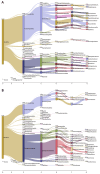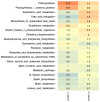Exploring the Metatranscriptome of Bacterial Communities of Two Moss Species Thriving in Different Environments-Terrestrial and Aquatic
- PMID: 38732425
- PMCID: PMC11085137
- DOI: 10.3390/plants13091210
Exploring the Metatranscriptome of Bacterial Communities of Two Moss Species Thriving in Different Environments-Terrestrial and Aquatic
Abstract
Mosses host diverse bacterial communities essential for their fitness, nutrient acquisition, stress tolerance, and pathogen defense. Understanding the microbiome's taxonomic composition is the first step, but unraveling their functional capabilities is crucial for grasping their ecological significance. Metagenomics characterizes microbial communities by composition, while metatranscriptomics explores gene expression, providing insights into microbiome functionality beyond the structure. Here, we present for the first time a metatranscriptomic study of two moss species, Hypnum cupressiforme (Hedw.) and Platyhypnidium riparioides (Hedw.) Dixon., renowned as key biomonitors of atmospheric and water pollution. Our investigation extends beyond taxonomic profiling and offers a profound exploration of moss bacterial communities. Pseudomonadota and Actinobacteria are the dominant bacterial phyla in both moss species, but their proportions differ. In H. cupressiforme, Actinobacteria make up 62.45% and Pseudomonadota 32.48%, while in P. riparioides, Actinobacteria account for only 25.67% and Pseudomonadota 69.08%. This phylum-level contrast is reflected in genus-level differences. Our study also shows the expression of most genes related to nitrogen cycling across both microbiomes. Additionally, functional annotation highlights disparities in pathway prevalence, including carbon dioxide fixation, photosynthesis, and fatty acid biosynthesis, among others. These findings hint at potential metabolic distinctions between microbial communities associated with different moss species, influenced by their specific genotypes and habitats. The integration of metatranscriptomic data holds promise for enhancing our understanding of bryophyte-microbe partnerships, opening avenues for novel applications in conservation, bioremediation, and sustainable agriculture.
Keywords: Hypnales; Hypnum cupressiforme; Platyhypnidium riparioides; bacterial communities; host microbiome; metatranscriptome; moss; sequencing.
Conflict of interest statement
The authors declare no conflicts of interest.
Figures



Similar articles
-
Antarctic ice-free terrestrial microbial functional redundancy in core ecological functions and microhabitat-specific microbial taxa and adaptive strategy.Environ Microbiome. 2025 Jun 13;20(1):70. doi: 10.1186/s40793-025-00735-0. Environ Microbiome. 2025. PMID: 40514722 Free PMC article.
-
Chemical Composition, Lipid-Soluble Bioactive Compounds and Potential Health Benefits of the Moss Hypnum cupressiforme Hedw.Plants (Basel). 2023 Dec 18;12(24):4190. doi: 10.3390/plants12244190. Plants (Basel). 2023. PMID: 38140517 Free PMC article.
-
Novel bacterial lineages associated with boreal moss species.Environ Microbiol. 2018 Jul;20(7):2625-2638. doi: 10.1111/1462-2920.14288. Epub 2018 Aug 22. Environ Microbiol. 2018. PMID: 29901277
-
Macrophyte-Based Assessment of Upland Rivers: Bioindicators and Biomonitors.Plants (Basel). 2023 Mar 19;12(6):1366. doi: 10.3390/plants12061366. Plants (Basel). 2023. PMID: 36987054 Free PMC article.
-
Reviewing bryophyte-microorganism association: insights into environmental optimization.Front Microbiol. 2024 Jun 14;15:1407391. doi: 10.3389/fmicb.2024.1407391. eCollection 2024. Front Microbiol. 2024. PMID: 38946907 Free PMC article.
Cited by
-
Antarctic ice-free terrestrial microbial functional redundancy in core ecological functions and microhabitat-specific microbial taxa and adaptive strategy.Environ Microbiome. 2025 Jun 13;20(1):70. doi: 10.1186/s40793-025-00735-0. Environ Microbiome. 2025. PMID: 40514722 Free PMC article.
References
-
- Quadt-Hallmann A., Benhamou N., Kloepper J.W. Bacterial Endophytes in Cotton: Mechanisms of Entering the Plant. Can. J. Microbiol. 1997;43:577–582. doi: 10.1139/m97-081. - DOI
-
- During H.J., Tooren B.F.V. Bryophyte Interactions with Other Plants. Bot. J. Linn. Soc. 1990;104:79–98. doi: 10.1111/j.1095-8339.1990.tb02212.x. - DOI
Grants and funding
LinkOut - more resources
Full Text Sources

